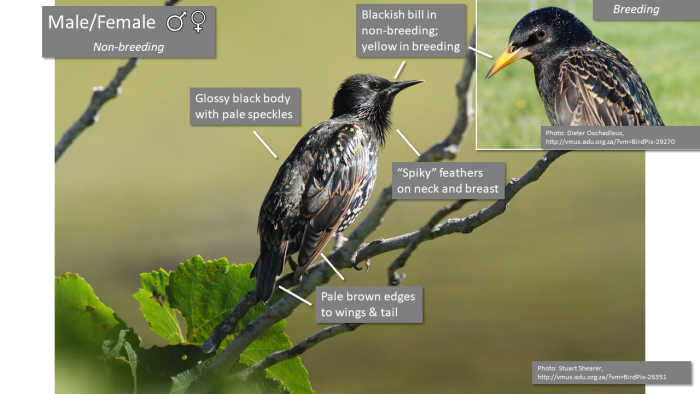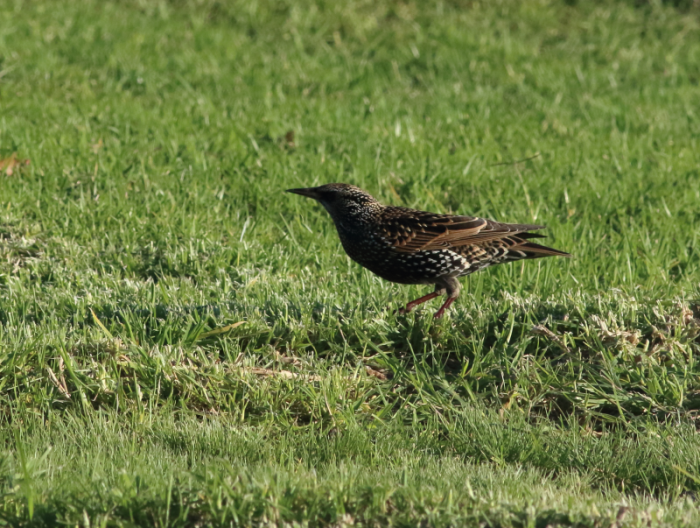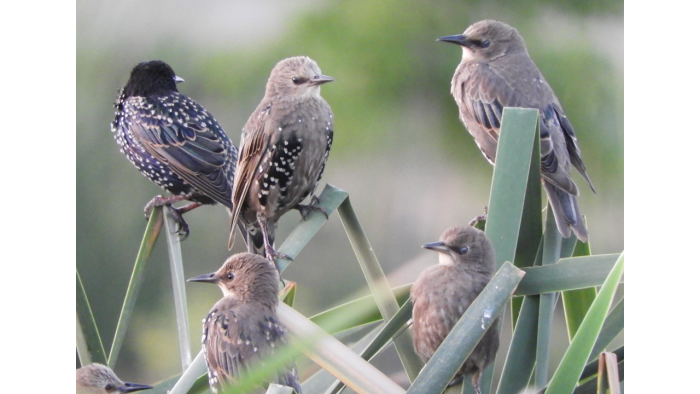Identification
The Common (or European) Starling Sturnus vulgaris can be identified by its short tail, pointed head, triangular-shaped wings, and pale speckles on its wings and body. Common Starlings look black in colour, when seen at a distance, but at closer range they are glossy with a sheen of purple and green (this is known as iridescence). Adult birds have blackish bills when not breeding and yellow bills when breeding.
In the air, their flight is often fast and direct. On the ground they move about confidently, often at a run. They have quite a range of vocalizations.

Juvenile birds are grey-brown in colour with speckling only appearing at about one year of age.

Habitat
In South Africa, they are mainly found in and around cities and towns. Their favoured habitats are grass lawns and sports fields where they often look for food, mainly invertebrates, by probing into the ground with their sharp bills.

Distribution
Common Starlings are native to Eurasia, north Africa, and Japan, but were introduced to Australia, New Zealand, North America, Argentina, and South Africa. They are considered a serious agricultural pest, in some of these regions, but not so much in South Africa. They were introduced to Cape Town in 1897 by Cecil John Rhodes. The story of their range expansion is here.
They mainly occur in the southern half of South Africa, especially along the coastline, and they are by far most commonly found in urban and agricultural areas. Common Starlings are always closely associated with humans. They do well in urban areas.

There are recent observations of Common Starlings potentially increasing their range in Namibia too. You can read about it in Biodiversity Observations.
Behaviour
Common Starlings are gregarious and noisy birds. They are often found in pairs or small groups. Flock size is highly variable but they can form massive, noisy flocks (known as murmurations), especially near their roosting sites.


They mainly eat insects and other invertebrates which they supplement with fruit, seeds and nectar. Common Starlings do most of their foraging on the ground, plucking up food items or probing the soil for underground prey.
They build an untidy nest in a natural or artificial cavity, during breeding season (September to December). They lay about four or five glossy, pale blue eggs, which take two weeks to hatch. The young remain in the nest for another three weeks before fledging.

Further Resources
Species text from the first Southern African Bird Atlas Project (SABAP1), 1997.
Virtual Museum (BirdPix > Search VM > By Scientific or Common Name).
The story of its introduction to South Africa: Impacts of Rhodes on Biodiversity 3 : Common Starling
More common names: Europese Spreeu (Afrikaans); Étourneau Sansonnet (French); Star (German); Spreeuw (Dutch).
Recommended citation format: Loftie-Eaton M and Daniel KA 2022. Common Starling Sturnus vulgaris. Bird Feeder Project. Biodiversity and Development Institute. Available Online at http://thebdi.org/2022/03/22/common-starling-sturnus-vulgaris/

